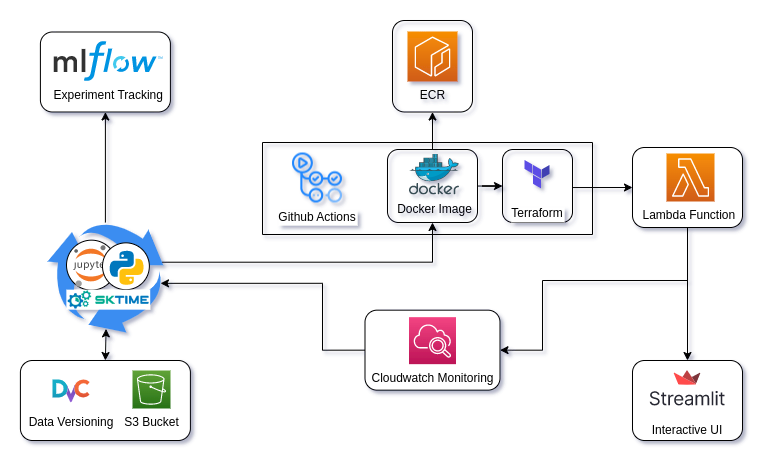



In this project I demonstrate a simple architecture for serverless ML model deployment, building in MLOps principles such as experiment tracking, data versioning, CI/CD and monitoring.
Purpose: To show how MLOps principles can be used even in small scale, simple ML projects using only open source tools and free-tier cloud services.
The focus is on minimal the time/effort to go from experimentation to a deployed model... not specifically on sophisticated timeseries forecasting techniques.
- Jupyter for data exploration and experimentation
- Custom Python package for refactoring code into a reusable pipeline
- Sktime as ML framework for timeseries
- DVC for data versioning, synced to AWS S3
- Mlflow for experiment tracking
- AWS Lambda for serverless model inference
- Streamlit web-app for interactive demo →
- Automated CI/CD pipeline using Github-actions for the following:
- Running pre-commit hooks for linting, style, type-checking
- Running pytest for unit testing
- Building Docker container image & push to AWS ECR
- Deploying cloud infra using Terraform (infra-as-code)
- Monitoring using AWS Cloudwatch.
The energy consumption dataset comes from data.gov.uk: "Energy Trends" published by the BEIS department. Additional data on historic Weather Trends (UK average) were also sourced from gov.uk.
Data ingest from the above sources is automated, currently just stored as .csv files (maybe in the future I would load these into a DB). For reproducibility - all analysis in this repo was performed on the above tables dated Oct 2022. Raw files for this date are made available in the repo under data/raw. All other data files require DVC to be installed with credentials to pull from my private S3 bucket.
Note: In theory the data ingest scripts could be re-run in future to get the most up-to-date tables, however the exact file formatting has been known to be adjusted over time. We might need to update the data cleaning/transformation scripts if this happens.
- Data files parsed, transformed into monthly timeseries dataframe.
- Temporal train-test split (80:20) applied.
- Target variable (for forecasting) was "Total Energy" consumption.
- Saved as .csv
- DVC used for data versioning, synced to S3 remote.
- See
notebooks/03_data_exploration.ipynbfor visuals and commentary
- Best forecaster model was AutoARIMA (Mean Absolute Percentage Error 0.052)
- Big deviation in energy consumption vs forecast seen during Covid 2019 (expected)
- Todo:
- Further model experimentation and hyperparam tuning
- Windowed cross-validation
All these todo items should be way quicker to iterate on now that CI/CD is configured
- Built multi-stage Docker image, pushed to ECR (keeping image size small, <300Mb)
- Used Terraform to deploy all cloud resources. Enables easy
terraform destroyto teardownall cloud resources if it starts to cost £££. - Set up unit testing with pytest and automated CI using pre-commit.
- Configured Github-actions to automate this all as a CI/CD pipeline.
- Other notes:
- Deployed inference api as a serverless lambda function.
- Deploy interactive front-end as Streamlit web-app.
- Keeping lightweight front-end by abstracting all ML code to lambda.
I abstracted away model inference from the front-end intentionally. Keeps architecture clean, front-end deployment lightweight. Is scalable and can be updated separately as model is improved.
All developement is done inside a Docker devcontainer, should even work OK inside a Github Codespace. Requires the following Github secrets to be configured:
- AWS_ACCESS_KEY_ID
- AWS_SECRET_ACCESS_KEY
- AWS_DEFAULT_REGION
All code developed for Python 3.9.13.
requirements.txtand.devcontainer/Dockerfilefor all dependenciesapp_streamlit/requirements.txtfor front-end app dependenciespyproject.tomlfor lambda function dependencies
The following commnds may be useful to configure/init your local copy of this repo
pre-commit install # Configures git-hooks for code linting etc
pre-commit run --all-files # Run all pre-commit hooks
terraform init # Requires AWS credentials to be configured.
make requirements # Install dependencies
make data # Process all data
make style # Apply black formatter
make streamlit # Launch web-app locally- Add prediction intervals.
- Add pipeline to download latest datafiles from gov.uk and update models.
- Introduce API gateway to expose forecaster as an open REST API.
- Further model experimentation and hyperparam tuning.

